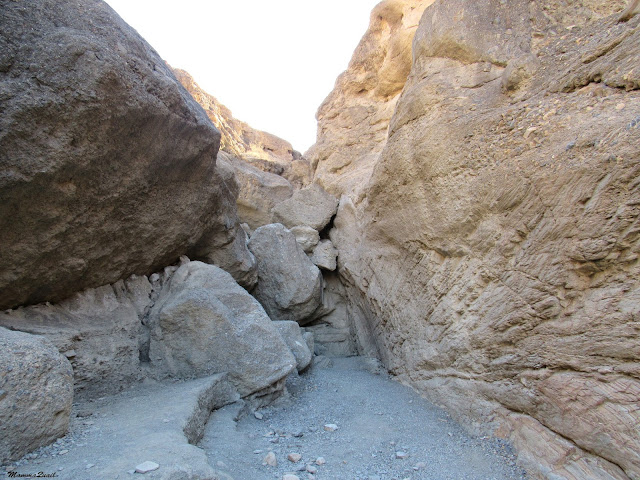 |
| Mosaic Formation |
Date: November 27, 2016
Place: Mosaic Canyon, Death Valley National Park, California
Coordinates: 36.571920, -117.144279
Distance: 4.1 miles
Level: moderate
On Friday morning we broke camp and drove back south to Stovepipe Wells. It was our last day at Death Valley and we wanted to go on a nice hike before starting on our long way back to the Bay Area. Taking the recommendation of the ranger we've spoken to on the previous day we decided to hike the nearby Mosaic Canyon.
We drove up the large alluvial fan to the canyon mouth. Many cars were parked there already but we managed to find a spot.
A couple of ravens were hanging by the canyon mouth near the parking lot. They didn't get too close to the hikers but they seemed unafraid and curious.
 |
| Raven |
 |
| Our hike as captured by Pappa Quail's GPS |
 |
| Mosaic Formation |
Mosaic Canyon narrowed right at its beginning. There were so many people inside on that day that it became a serious challenge to shoot a human-free photo of the canyon. Moreover - at times we had to wait in line to go past a particular narrows section.
 |
| Curves |
 |
| A tight spot: Rock Nettle |
The canyon cut right through these layers, laying them visible to us as we walked between the rock walls.
We passed through the first narrows and found ourselves in a wide open area. The photo below is a bit misleading, as I had to position myself very carefully and time the shot just right to snap it at the split second there were no other people in the frame.
 |
| Mosaic Canyon last first narrows |
 |
| Desert Holly, Atriplex hymenelytra |
More formations, however, were revealed to those who moved further up Mosaic Canyon. Not all the formations we saw were of rock: some nice stalactite-like dried mud formations decorated the softer sides of the canyon.
Soon we arrived at a place where the canyon was blocked by a pile of collapsed boulders. There were two bypass possibilities, both seemed equally precarious. We observed the possibilities, and the people who tried this way or that, and made our choice to climb along the narrow gap behind the main large boulder that had collapsed into the canyon. It was a slow business but we all made it up and around the canyon block.
 |
| Boulder Block |
It was well worth it, though. Slot canyons are much fun.
Beyond the third narrows the mosaic formations appeared again, layering the canyon walls. Once again I saw the variety within this formation and I wondered if these upper layers are folded continuation of those I've seen at he entrance to the canyon, or perhaps different conglomerates that hardened on a different geological time.
Going further up the canyon meant some climbing through some tight narrows. Nothing too challenging, but quite exciting and fun to chikas and adult quails alike.
At the second canyon block there was no climbing the rocks around it. We had to go up the side slope and bypass that place in a wide arc. Luckily the bypass was well marked. It seemed also that fewer hikers continued beyond that point because after descending back to the creek bed above the block there were just a few more hikers behind us. In fact, we were almost alone.
We made it up the forth and last narrows. The last narrows for any normal hiker, that is. Because any progress beyond that required rock climbing skills that we did not possess.
 |
| End Waterfall - our turning point |
Meanwhile Pappa Quail photographed a cute little rock wren :-)
 |
| Rock Wren |
Arriving at the top of one waterfall we had climbed its side on the way up I suggested that we should slide down it on our behinds. The chikas quickly jumped on the idea and slid down the fall shouting with thrill. Papa Quail passed on the pleasure and climbed carefully down along the side. I watched the three of them below and wondered if the rock chute was narrow enough to accommodate my behind. Eventually I too reconnected with my inner chika and slid down the smooth waterfall.
 |
| Slide |
As we went further down the view outside the canyon opened up wider. It was a bright, sunny day, and the temperatures were very mild. Inside the canyon we were also protected from the wind that still raged outside.
By the time we made it through the first narrows again on the way out, the sun had already turned so our passage was completely shaded. It was afternoon already.
Pappa Quail and I had hiked Mosaic Canyon a long time ago, on our first ever visit to Death Valley NP. I was not able to recall anything of that first hike, not even as I walked through the striking formations a second time around. To me it was a first time discovery. And in my memory it is now etched as one of the nicest hikes in this magnificent park.

















This is a vry impressive hike
ReplyDeleteIt's an impressive place. I wish I could stay there longer and explore some more.
Deletethe desert in all its glory... I wonder what it looked like last month :-)
ReplyDeleteNe too ... They had a few sand storms there last month. It put a damper on many people's plans.
Delete